Abstract
The induction of DNA polymerase activity and of DNA synthesis in polyoma virus-infected mouse kidney cells is inhibited by actinomycin D and cycloheximide, even in cells that are already T-antigen positive. This indicates that the induction of the DNA-synthesizing apparatus requires transcription and translation. The increase in cellular DNA polymerase activity and in the DNA synthesizing capacity follows the appearance of T-antigen only after a characteristic lag period of several hours.
Full text
PDF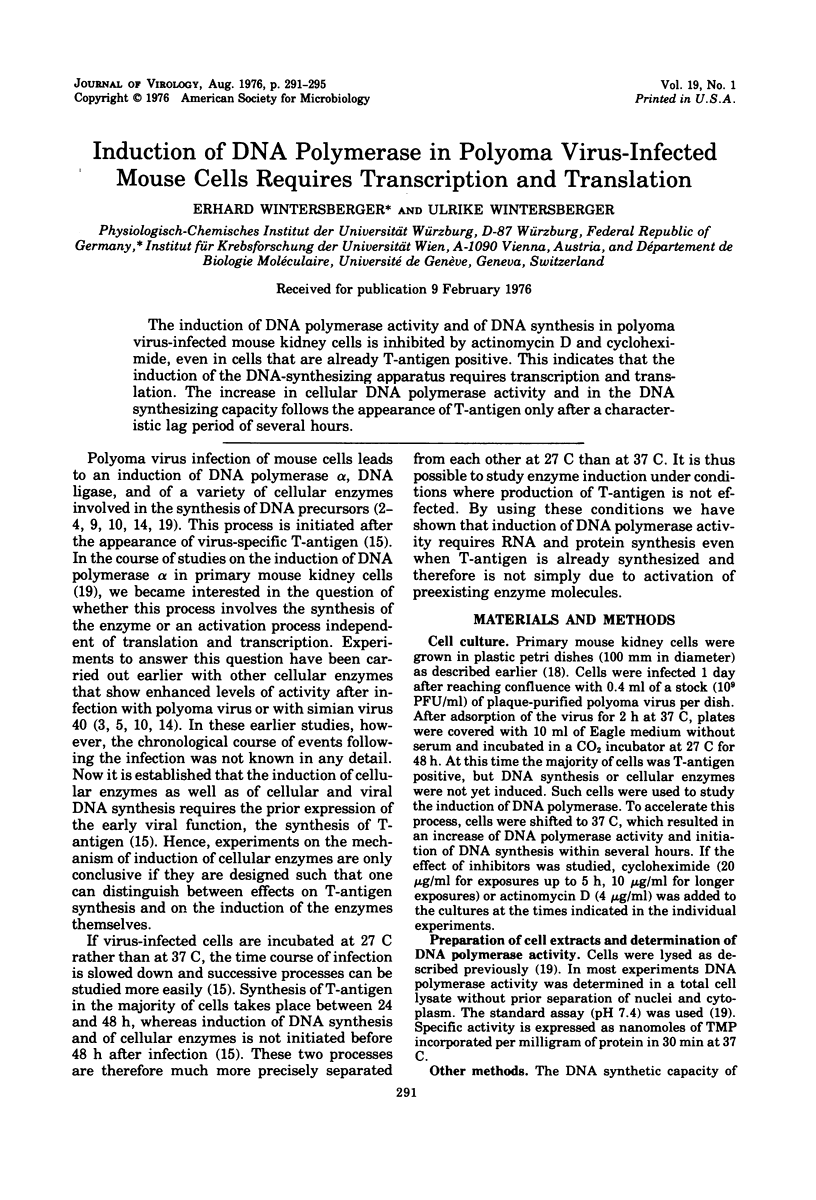
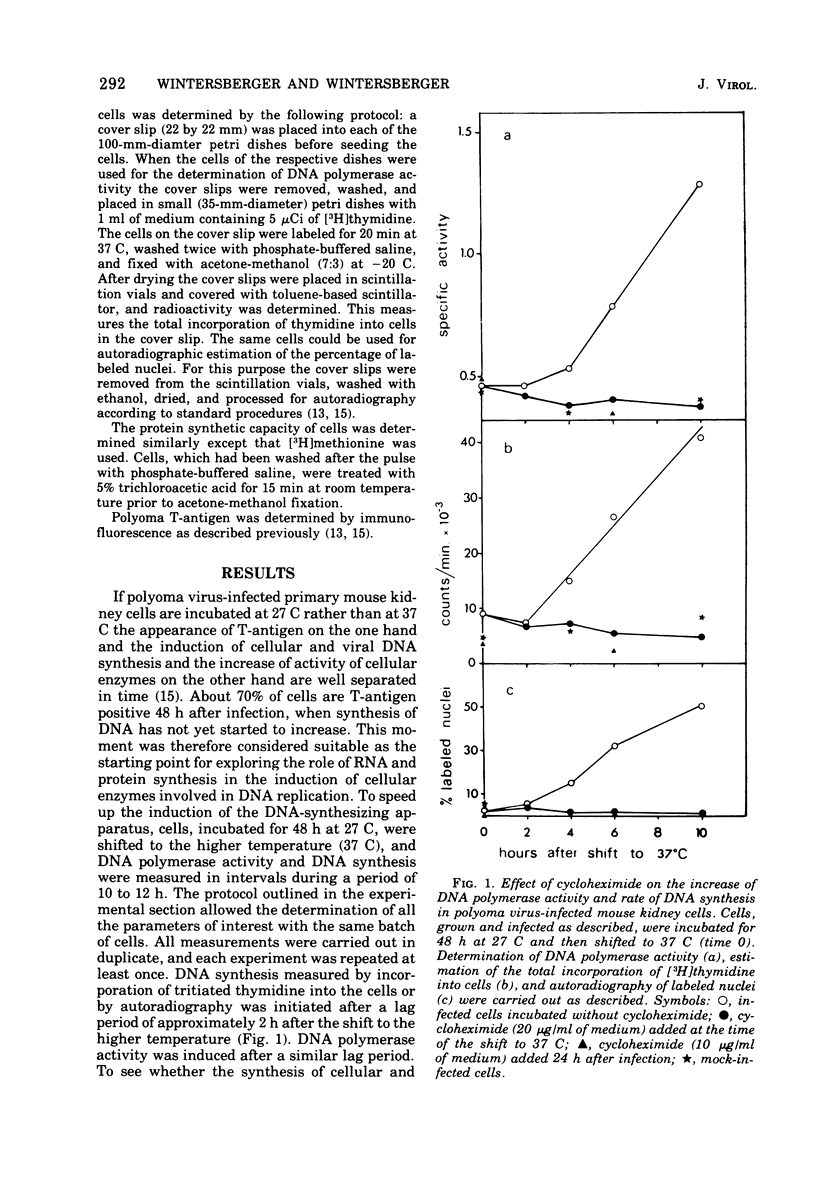
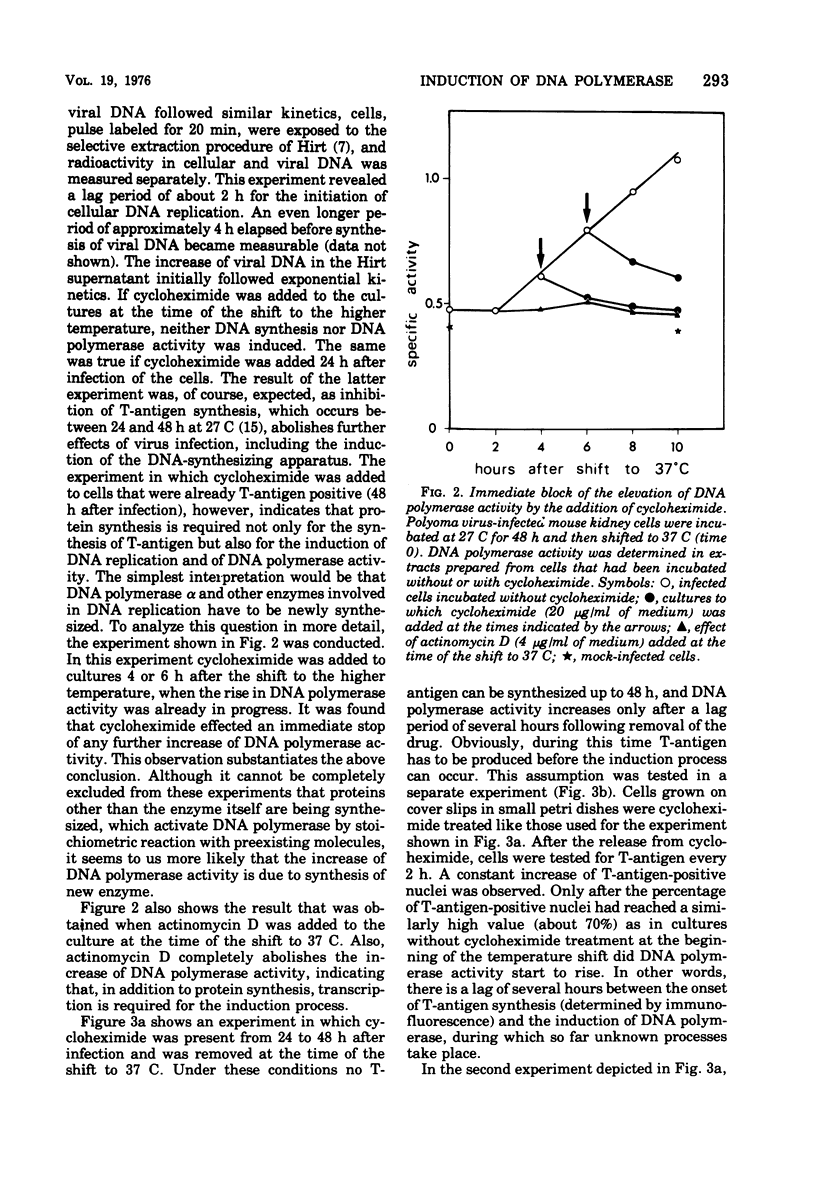
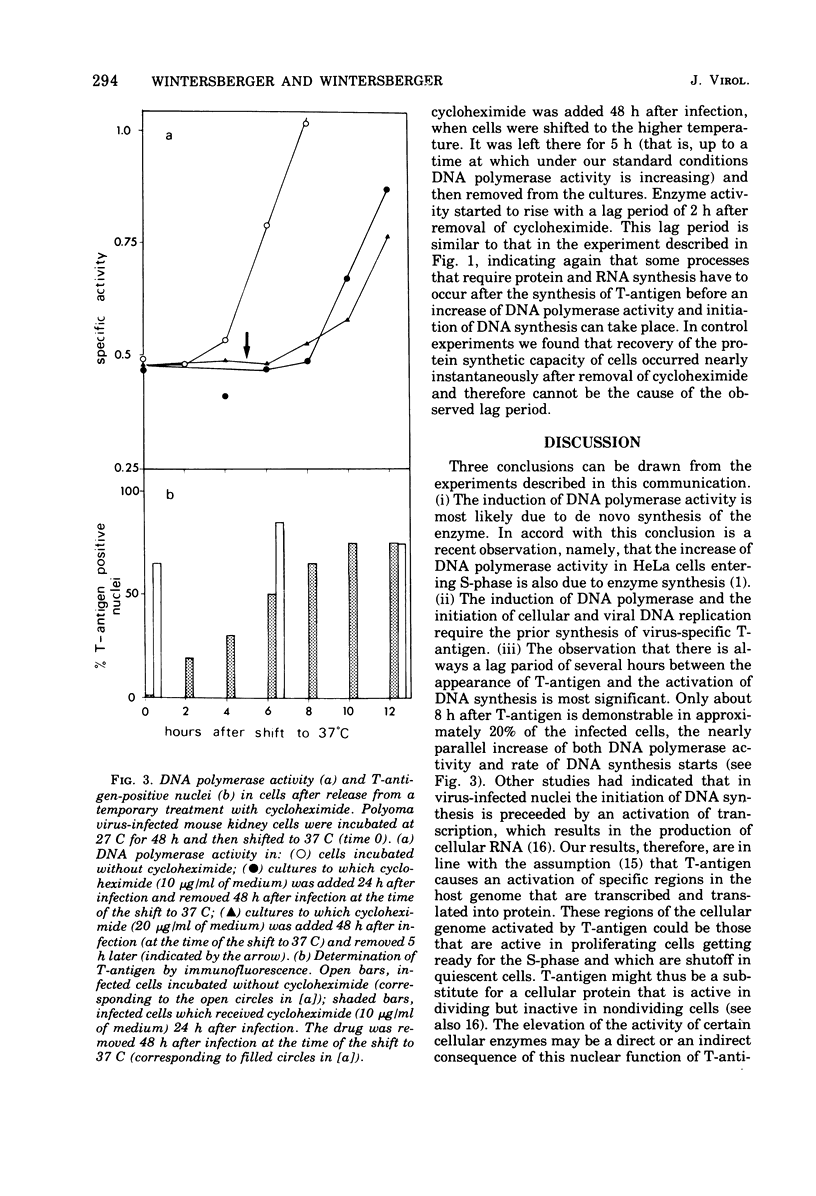
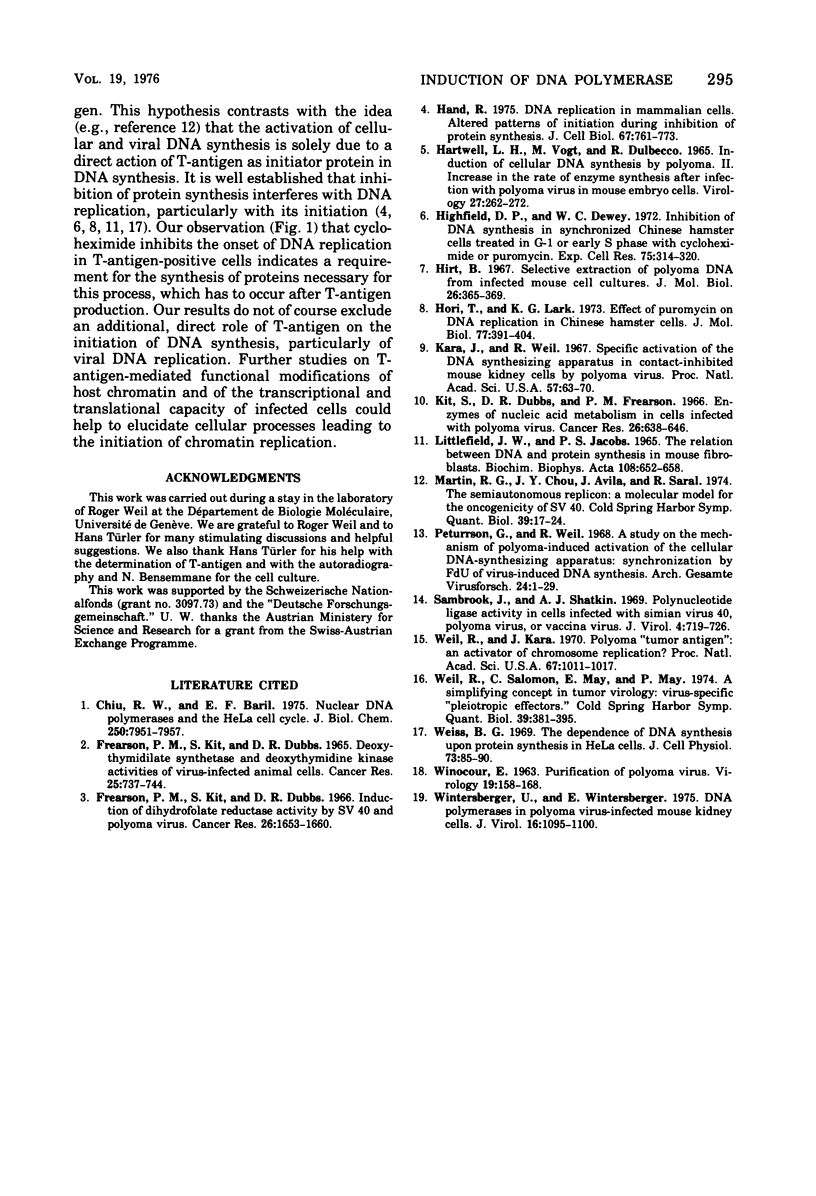
Selected References
These references are in PubMed. This may not be the complete list of references from this article.
- Chiu R. W., Baril E. F. Nuclear DNA polymerases and the HeLa cell cycle. J Biol Chem. 1975 Oct 10;250(19):7951–7957. [PubMed] [Google Scholar]
- FREARSON P. M., KIT S., DUBBS D. R. DEOXYTHYMIDYLATE SYNTHETASE AND DEOXYTHYMIDINE KINASE ACTIVITIES OF VIRUS-INFECTED ANIMAL CELLS. Cancer Res. 1965 Jun;25:737–744. [PubMed] [Google Scholar]
- Frearson P. M., Kit S., Dubbs D. R. Induction of dihydrofolate reductase activity by SV40 and polyoma virus. Cancer Res. 1966 Aug;26(8):1653–1660. [PubMed] [Google Scholar]
- Hand R. DNA replication in mammalian cells. Altered patterns of initiation during inhibition of protein synthesis. J Cell Biol. 1975 Dec;67(3):761–773. doi: 10.1083/jcb.67.3.761. [DOI] [PMC free article] [PubMed] [Google Scholar]
- Hartwell L. H., Vogt M., Dulbecco R. Induction of cellular DNA synthesis by polyoma virus. II. Increase in the rate of enzyme synthesis after infection with polyoma virus in mouse kidney cells. Virology. 1965 Nov;27(3):262–272. doi: 10.1016/0042-6822(65)90105-4. [DOI] [PubMed] [Google Scholar]
- Highfield D. P., Dewey W. C. Inhibition of DNA synthesis in synchronized Chinese hamster cells treated in G1 or early S phase with cycloheximide or puromycin. Exp Cell Res. 1972 Dec;75(2):314–320. doi: 10.1016/0014-4827(72)90435-1. [DOI] [PubMed] [Google Scholar]
- Hirt B. Selective extraction of polyoma DNA from infected mouse cell cultures. J Mol Biol. 1967 Jun 14;26(2):365–369. doi: 10.1016/0022-2836(67)90307-5. [DOI] [PubMed] [Google Scholar]
- Hori T., Lark K. G. Effect of puromycin on DNA replication in Chinese hamster cells. J Mol Biol. 1973 Jul 5;77(3):391–404. doi: 10.1016/0022-2836(73)90446-4. [DOI] [PubMed] [Google Scholar]
- Kit S., Dubbs D. R., Frearson P. M. Enzymes of nucleic acid metabolism in cells infected with polyoma virus. Cancer Res. 1966 Apr;26(4):638–646. [PubMed] [Google Scholar]
- Kára J., Weil R. Specific activation of the DNA-synthesizing apparatus in contact-inhibited mouse kidney cells by polyoma virus. Proc Natl Acad Sci U S A. 1967 Jan;57(1):63–70. doi: 10.1073/pnas.57.1.63. [DOI] [PMC free article] [PubMed] [Google Scholar]
- Littlefield J. W., Jacobs P. S. The relation between DNA and protein synthesis in mouse fibroblasts. Biochim Biophys Acta. 1965 Dec 9;108(4):652–658. doi: 10.1016/0005-2787(65)90061-4. [DOI] [PubMed] [Google Scholar]
- Martin R. G., Chou J. Y., Avila J., Saral R. The semiautonomous replicon: a molecular model for the oncogenicity of SV40. Cold Spring Harb Symp Quant Biol. 1975;39(Pt 1):17–24. doi: 10.1101/sqb.1974.039.01.005. [DOI] [PubMed] [Google Scholar]
- Pétursson G., Weil R. A study on the mechanism of polyoma-induced activation of the cellular DNA-synthesizing apparatus. Synchronization by FUdR of virus-induced DNA synthesis. Arch Gesamte Virusforsch. 1968;24(1):1–29. doi: 10.1007/BF01242898. [DOI] [PubMed] [Google Scholar]
- Sambrook J., Shatkin A. J. Polynucleotide ligase activity in cells infected with simian virus 40, polyoma virus, or vaccinia virus. J Virol. 1969 Nov;4(5):719–726. doi: 10.1128/jvi.4.5.719-726.1969. [DOI] [PMC free article] [PubMed] [Google Scholar]
- WINOCOUR E. Purification of polyoma virus. Virology. 1963 Feb;19:158–168. doi: 10.1016/0042-6822(63)90005-9. [DOI] [PubMed] [Google Scholar]
- Weil R., Kára J. Polyoma "tumor antigen": an activator of chromosome replication? Proc Natl Acad Sci U S A. 1970 Oct;67(2):1011–1017. doi: 10.1073/pnas.67.2.1011. [DOI] [PMC free article] [PubMed] [Google Scholar]
- Weil R., Salomon E., May E., May P. A simplifying concept in tumor virology: virus-specific "pleiotropic effectors". Cold Spring Harb Symp Quant Biol. 1975;39(Pt 1):381–395. doi: 10.1101/sqb.1974.039.01.050. [DOI] [PubMed] [Google Scholar]
- Weiss B. G. The dependence of DNA synthesis on protein synthesis in HeLa S3 cells. J Cell Physiol. 1969 Feb;73(1):85–90. doi: 10.1002/jcp.1040730112. [DOI] [PubMed] [Google Scholar]
- Wintersberger U., Wintersberger E. DNA polymerases in polyoma virus-infected mouse kidney cells. J Virol. 1975 Nov;16(5):1095–1100. doi: 10.1128/jvi.16.5.1095-1100.1975. [DOI] [PMC free article] [PubMed] [Google Scholar]


